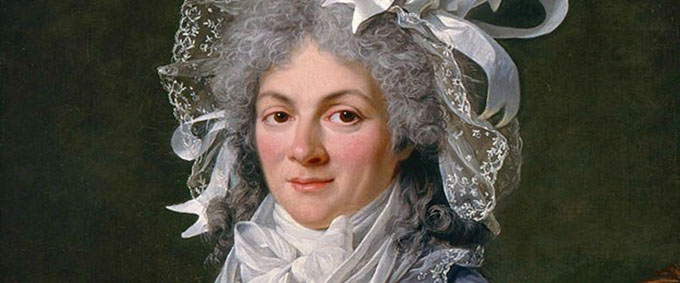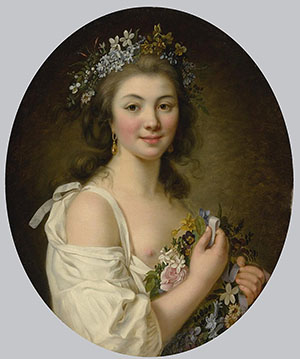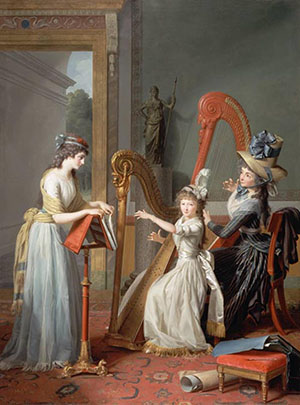
I was a weak, lazy and cowardly boy. She made me a fairly bold and kind-hearted man ”
It is with these words that Louis-Philippe would have paid homage to Madame de Genlis, the first woman to accede to the post of governor of princes, and who took charge of her education. If the aristocrats of the XVIII th century entrusted their young children to nannies, they went over to the men for the education of boys when it came time to instruction.
The promotion of Madame de Genlis is unprecedented, and her reflection on pedagogy is worth stopping at. Twenty years after Emile de Rousseau, she offers a true educational treatise in her novel by letters, Adèle and Théodore . In these times of confinement where, faced with the closure of schools, teachers and parents are urged to reinvent the support of students, don’t the great texts on learning find a new echo? And isn’t this an opportunity to rediscover a figure that is too little known today?
While the essay Women and literature (published by Gallimard, under the direction of Martine Reid), replaces it in the pantheon of the authors who count, let us return to the life and work of Madame de Genlis.
Educational space

Born in the nobility of the sword in 1746, Caroline-Stéphanie-Félicité du Crest married at 17 the Count de Genlis, of whom she has two daughters. Lady companion of the Duchess of Chartres, she quickly became the mistress of the Duke of Chartres who chose to entrust her with the education of her two daughters, Mme de Blois and Mlle
Born in the nobility of the sword in 1746, Caroline-Stéphanie-Félicité du Crest married at 17 the Count de Genlis, of whom she has two daughters. Lady companion of the Duchess of Chartres, she quickly became the mistress of the Duke of Chartres who chose to entrust her with the education of her two daughters, Mme de Blois and Mlle d’Orléans, in 1779, then, in 1782, of her son, including the Duke of Valois, first prince by blood, heir to the family fortune and titles, future King Louis Philippe. The appointment of this “petticoat” created a scandal in high society.
To give them their first ideal training away from the “corrupting” world, she retired with her pupils, boys and girls, to the Bellechasse pavilion, which the duke had built on the grounds of the Convent of Saint Sepulcher, according to the plans that ‘she prepared. In the novel by letters Adèle and Théodore, she describes the ideal educational house, which she designed.
The whole house is designed like an open book where children wander through knowledge. Upon awakening, the historic decorations of the rooms give notions that children keep in memory all their lives. In the living room, they offer topics for family discussions.
The ancient history, the history of France and the holy history are present in the tapestries which illustrate the history of the great men but also of the great heroines, “the most famous Roman ladies of the time of the Kings and the Republic, Lucrèce, Clélie, Cornélie, Porcie […] and all the empresses up to Constantine. ”
These examples can thus be engraved in the memory of children. Each room is decorated according to a theme and a historical period. On the stairs take place geographic maps, skillfully placed to retain the position of countries from north to south, from top to bottom of the house as the globe.
To complete this fixed device, screens, ancestors of our posters, constitute temporary exhibitions:
“I still have six large painted screens in a storage unit which give an idea of the chronology of the stories of England, Spain, Portugal, Germany, Malta and the Turks. I also have a very large supply of small hand screens, all geographic, of old and modern maps, and on the back of which I have written in English or Italian a clear and short historical description of the countries represented on the map. “
Madame de Genlis uses new educational tools, such as the magic lantern, or numerous models , to which the museum of arts and crafts devoted an exhibition in 2002.
The garden is not left to chance by nature, everything can be useful. “Large carpets of lawns and young plantations of foreign trees” provide an ideal complement to botany. They are labeled, a gardener is there to teach the children where they come from and the necessary care. Small mountains in the park also allow you to exercise, but also to work on the geometry on the ground:
“At the walk, our children are still only practicing jumping, running, in a year, we will accustom them, as Rousseau advises, to measure with eyes, any space, how much such aisle can have trees, how many such pots have flower pots. “
Common instruction
In this house, girls and boys walk together in knowledge. But everyone also has special moments with the father or the mother. If the father teaches his son more about military art, the mother accompanies his daughter in her readings.
Madame de Genlis traces a reading program from the age of two to 18 for Adèle, where we find great writers like Fénelon, but also authors too often forgotten today, like Madame de La Fite and her dialogues, Ms. Riccoboni and her Peruvian Letters, the theater of Ms. Barbier, and of course the Letters of Ms. de Sévigné.
Languages are the object of regular practices. An English tutor Miss Bridget came to teach English to Adèle and Théodore, from the age of 6 months, to accustom them to the sounds. An Italian drawing teacher joins the teaching of the art of drawing and the language, with spirit and gaiety.
Each day is punctuated by a ritual program: washing, lunch, housekeeping, prayer, then reading accompanied by discussions, with the children. After family lunch and a walk in the gardens, we have fun looking at maps and paintings. Children draw, make portraits. In small games, the math lesson is done with chips. After dinner, we play different instruments and the children go to bed at 9 a.m.
Mme de Genlis is the author of children’s stories and plays, so staging is also part of family activities. At each session, play and teaching come together. Knowledge is always the subject of discussions with parents, who verify that it is well understood.
Experience at the heart of learning

The harp lesson given by Madame de Genlis to Mademoiselle d’Orléans, Jean Antoine Theodore Giroust. Dallas Museum of Art / Wikimedia , CC BY
Parents support children in their discoveries and ensure that they learn from each experience. When Theodore is greedy, after having discussed it, he is given a well-defined number of sweets which he will have to manage. For Adèle’s first visit to the world, she is allowed to adorn herself excessively, and eat so many cakes that she is sick of them, so that she can explain to her how disappointing her attitude was and that she learns from her mistakes. and don’t start again.
The visits, when leaving the house, then will be to see friends who are so many models: the family visits friends who have opened a hospital near Montpellier, in Brittany, friends who live near nature . Each experience must deeply mark the heart and the spirit.
The family organized a great trip as a teenager, heir to the Grand Tour , to Italy and then to Holland. Every moment in the car or outside also offers fun and educational games, exchanges on the readings of things seen between parents and children. Later, they also go to the theater and visit new companies, do research in the Encyclopedia to complete their learning.
Emigrated during the Revolution, Madame de Genlis received a pension from Napoleon Bonaparte, in exchange for a correspondence, then the title of inspector of public schools. In 1801, she sketched a project for rural schools for girls. When she died at 84 in 1831, her pupil the Duke of Orleans, who became king under the title of Louis Philippe, awarded her a solemn funeral. She is the author of more than 130 works.
Author Bio: Sandrine Aragon is a Researcher in French literature (Gender, reading, women and culture) at Sorbonne University
